Page 299 of 473
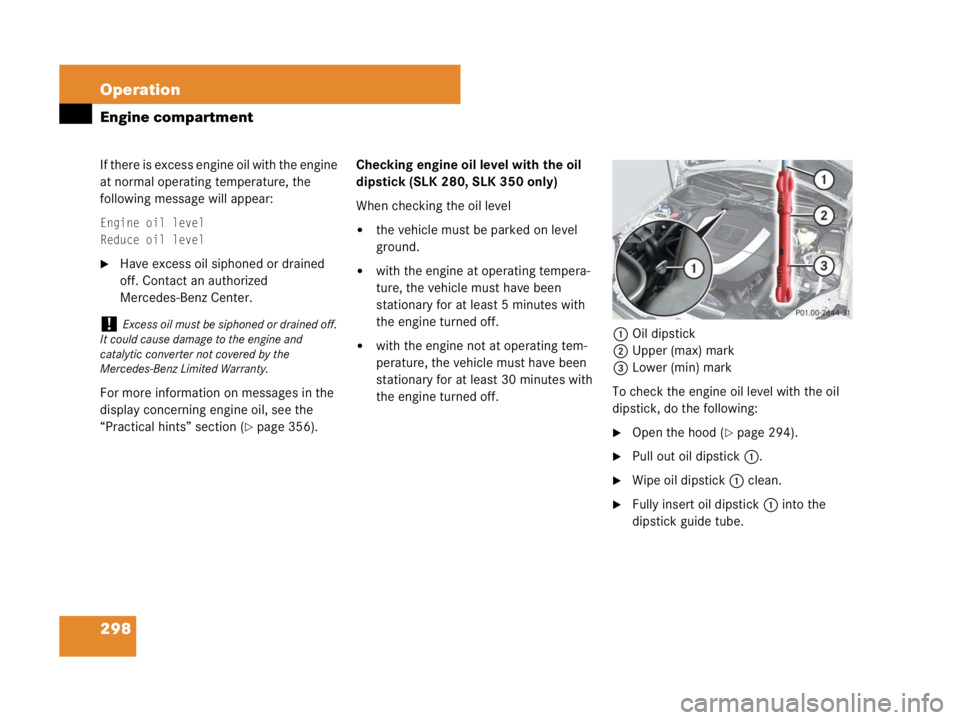
298 Operation
Engine compartment
If there is excess engine oil with the engine
at normal operating temperature, the
following message will appear:
Engine oil level
Reduce oil level
�Have excess oil siphoned or drained
off. Contact an authorized
Mercedes-Benz Center.
For more information on messages in the
display concerning engine oil, see the
“Practical hints” section (
�page 356).Checking engine oil level with the oil
dipstick (SLK 280, SLK 350 only)
When checking the oil level
�the vehicle must be parked on level
ground.
�with the engine at operating tempera-
ture, the vehicle must have been
stationary for at least 5 minutes with
the engine turned off.
�with the engine not at operating tem-
perature, the vehicle must have been
stationary for at least 30 minutes with
the engine turned off.1Oil dipstick
2Upper (max) mark
3Lower (min) mark
To check the engine oil level with the oil
dipstick, do the following:
�Open the hood (�page 294).
�Pull out oil dipstick1.
�Wipe oil dipstick1 clean.
�Fully insert oil dipstick1 into the
dipstick guide tube.
!Excess oil must be siphoned or drained off.
It could cause damage to the engine and
catalytic converter not covered by the
Mercedes-Benz Limited Warranty.
Page 301 of 473
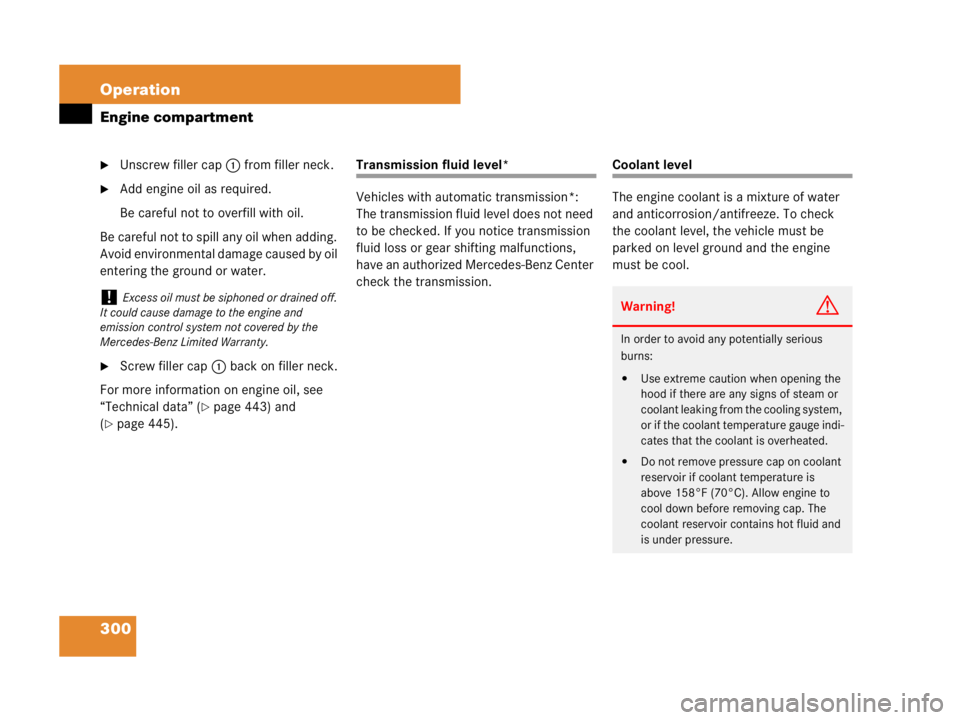
300 Operation
Engine compartment
�Unscrew filler cap1 from filler neck.
�Add engine oil as required.
Be careful not to overfill with oil.
Be careful not to spill any oil when adding.
Avoid environmental damage caused by oil
entering the ground or water.
�Screw filler cap1 back on filler neck.
For more information on engine oil, see
“Technical data” (
�page 443) and
(
�page 445).
Transmission fluid level*
Vehicles with automatic transmission*:
The transmission fluid level does not need
to be checked. If you notice transmission
fluid loss or gear shifting malfunctions,
have an authorized Mercedes-Benz Center
check the transmission.Coolant level
The engine coolant is a mixture of water
and anticorrosion/antifreeze. To check
the coolant level, the vehicle must be
parked on level ground and the engine
must be cool.
!Excess oil must be siphoned or drained off.
It could cause damage to the engine and
emission control system not covered by the
Mercedes-Benz Limited Warranty.Warning!G
In order to avoid any potentially serious
burns:
�Use extreme caution when opening the
hood if there are any signs of steam or
coolant leaking from the cooling system,
or if the coolant temperature gauge indi-
cates that the coolant is overheated.
�Do not remove pressure cap on coolant
reservoir if coolant temperature is
above 158°F (70°C). Allow engine to
cool down before removing cap. The
coolant reservoir contains hot fluid and
is under pressure.
Page 304 of 473
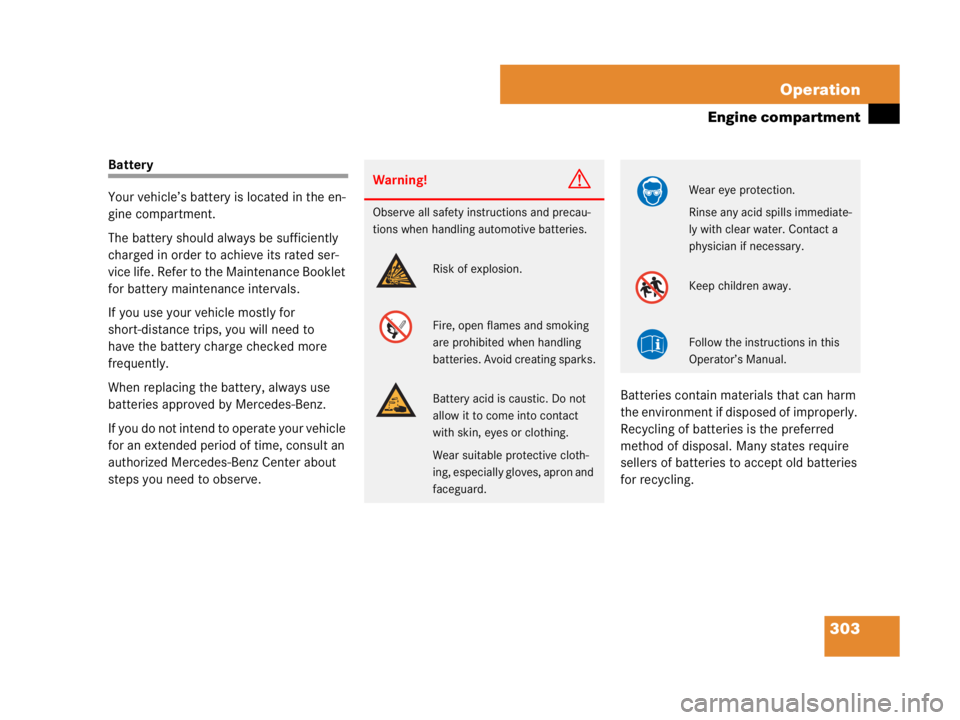
303 Operation
Engine compartment
Battery
Your vehicle’s battery is located in the en-
gine compartment.
The battery should always be sufficiently
charged in order to achieve its rated ser-
vice life. Refer to the Maintenance Booklet
for battery maintenance intervals.
If you use your vehicle mostly for
short-distance trips, you will need to
have the battery charge checked more
frequently.
When replacing the battery, always use
batteries approved by Mercedes-Benz.
If you do not intend to operate your vehicle
for an extended period of time, consult an
authorized Mercedes-Benz Center about
steps you need to observe.Batteries contain materials that can harm
the environment if disposed of improperly.
Recycling of batteries is the preferred
method of disposal. Many states require
sellers of batteries to accept old batteries
for recycling.
Warning!G
Observe all safety instructions and precau-
tions when handling automotive batteries.
Risk of explosion.
Fire, open flames and smoking
are prohibited when handling
batteries. Avoid creating sparks.
Battery acid is caustic. Do not
allow it to come into contact
with skin, eyes or clothing.
Wear suitable protective cloth-
ing, especially gloves, apron and
faceguard.
Wear eye protection.
Rinse any acid spills immediate-
ly with clear water. Contact a
physician if necessary.
Keep children away.
Follow the instructions in this
Operator’s Manual.
Page 333 of 473
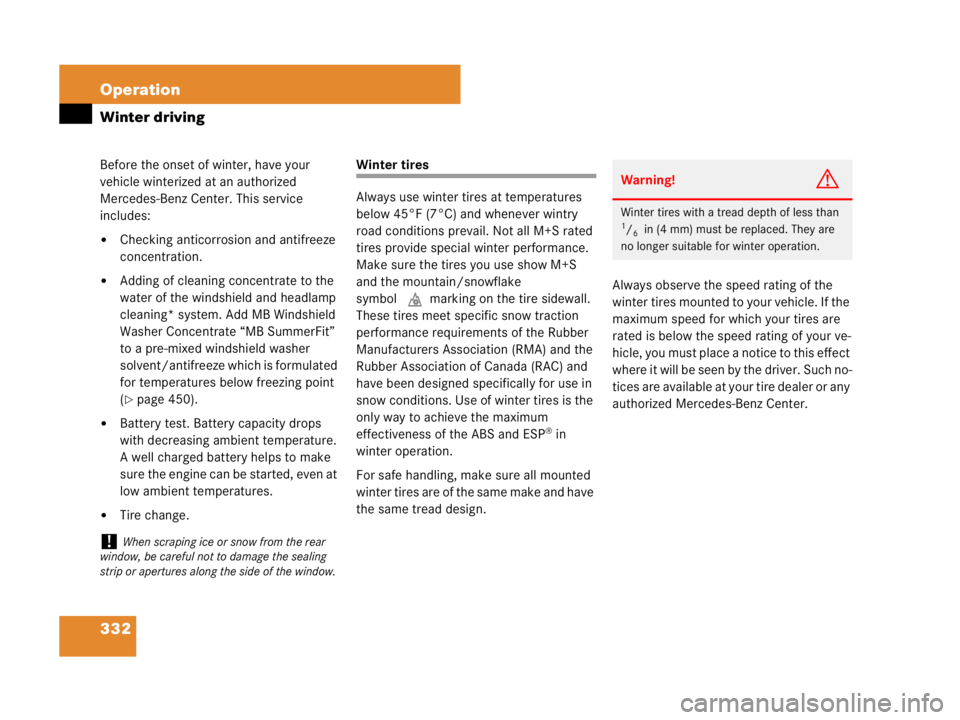
332 Operation
Winter driving
Before the onset of winter, have your
vehicle winterized at an authorized
Mercedes-Benz Center. This service
includes:
�Checking anticorrosion and antifreeze
concentration.
�Adding of cleaning concentrate to the
water of the windshield and headlamp
cleaning* system. Add MB Windshield
Washer Concentrate “MB SummerFit”
to a pre-mixed windshield washer
solvent/antifreeze which is formulated
for temperatures below freezing point
(
�page 450).
�Battery test. Battery capacity drops
with decreasing ambient temperature.
A well charged battery helps to make
sure the engine can be started, even at
low ambient temperatures.
�Tire change.
Winter tires
Always use winter tires at temperatures
below 45°F (7°C) and whenever wintry
road conditions prevail. Not all M+S rated
tires provide special winter performance.
Make sure the tires you use show M+S
and the mountain/snowflake
symbol.marking on the tire sidewall.
These tires meet specific snow traction
performance requirements of the Rubber
Manufacturers Association (RMA) and the
Rubber Association of Canada (RAC) and
have been designed specifically for use in
snow conditions. Use of winter tires is the
only way to achieve the maximum
effectiveness of the ABS and ESP
® in
winter operation.
For safe handling, make sure all mounted
winter tires are of the same make and have
the same tread design.Always observe the speed rating of the
winter tires mounted to your vehicle. If the
maximum speed for which your tires are
rated is below the speed rating of your ve-
hicle, you must place a notice to this effect
where it will be seen by the driver. Such no-
tices are available at your tire dealer or any
authorized Mercedes-Benz Center.
!When scraping ice or snow from the rear
window, be careful not to damage the sealing
strip or apertures along the side of the window.
Warning!G
Winter tires with a tread depth of less than 1/6 in (4 mm) must be replaced. They are
no longer suitable for winter operation.
Page 347 of 473
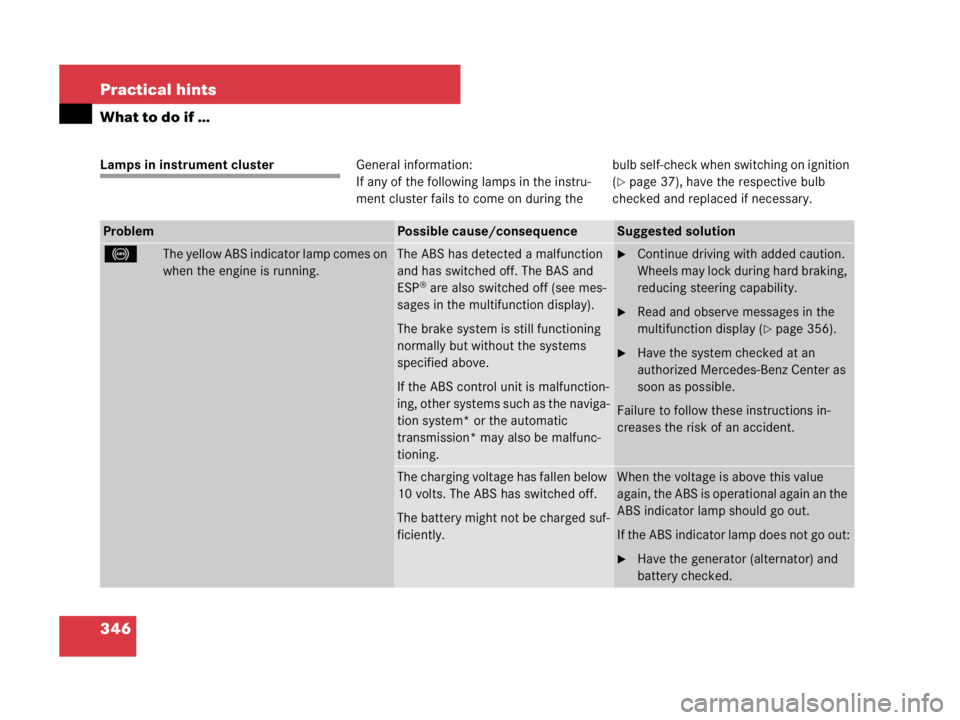
346 Practical hints
What to do if …
Lamps in instrument clusterGeneral information:
If any of the following lamps in the instru-
ment cluster fails to come on during thebulb self-check when switching on ignition
(
�page 37), have the respective bulb
checked and replaced if necessary.
ProblemPossible cause/consequenceSuggested solution
-The yellow ABS indicator lamp comes on
when the engine is running.The ABS has detected a malfunction
and has switched off. The BAS and
ESP
® are also switched off (see mes-
sages in the multifunction display).
The brake system is still functioning
normally but without the systems
specified above.
If the ABS control unit is malfunction-
ing, other systems such as the naviga-
tion system* or the automatic
transmission* may also be malfunc-
tioning.
�Continue driving with added caution.
Wheels may lock during hard braking,
reducing steering capability.
�Read and observe messages in the
multifunction display (
�page 356).
�Have the system checked at an
authorized Mercedes-Benz Center as
soon as possible.
Failure to follow these instructions in-
creases the risk of an accident.
The charging voltage has fallen below
10 volts. The ABS has switched off.
The battery might not be charged suf-
ficiently.When the voltage is above this value
again, the ABS is operational again an the
ABS indicator lamp should go out.
If the ABS indicator lamp does not go out:
�Have the generator (alternator) and
battery checked.
Page 348 of 473
347 Practical hints
What to do if …
ProblemPossible cause/consequenceSuggested solution
-The yellow ABS indicator lamp comes on
when the engine is running.The ABS is temporary not available.
The ESP® and the BAS are also un-
available.
The system’s self-diagnosis may not
be completed yet.
The brake system is still functioning
normally but without the systems
specified above.
�Drive a short distance with added
caution at a vehicle speed of above
12 mph (20 km/h).
When the ABS indicator lamp goes
out, the ABS, the ESP
®, and the BAS
are available again.
If the yellow ABS indicator lamp does not
go out:
�Continue driving with added caution.
�Have the system checked at an
authorized Mercedes-Benz Center as
soon as possible.
Failure to follow these instructions
increases the risk of an accident.
Page 349 of 473
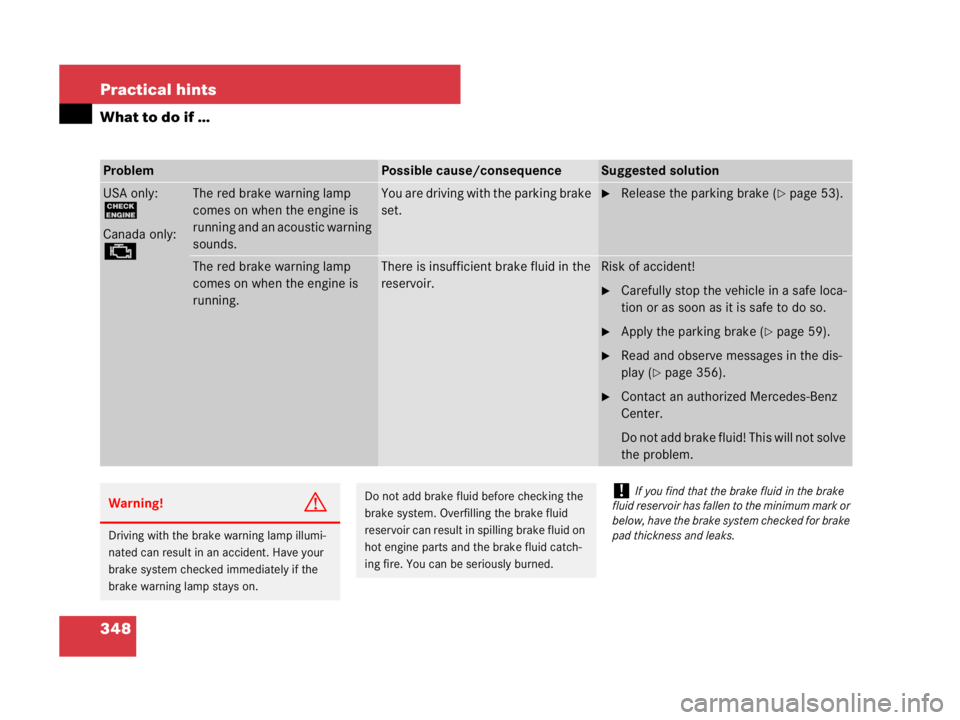
348 Practical hints
What to do if …
ProblemPossible cause/consequenceSuggested solution
USA only:
?
Canada only:
±
The red brake warning lamp
comes on when the engine is
running and an acoustic warning
sounds.You are driving with the parking brake
set.�Release the parking brake (�page 53).
The red brake warning lamp
comes on when the engine is
running.There is insufficient brake fluid in the
reservoir.Risk of accident!
�Carefully stop the vehicle in a safe loca-
tion or as soon as it is safe to do so.
�Apply the parking brake (�page 59).
�Read and observe messages in the dis-
play (
�page 356).
�Contact an authorized Mercedes-Benz
Center.
Do not add brake fluid! This will not solve
the problem.
Warning!G
Driving with the brake warning lamp illumi-
nated can result in an accident. Have your
brake system checked immediately if the
brake warning lamp stays on.
Do not add brake fluid before checking the
brake system. Overfilling the brake fluid
reservoir can result in spilling brake fluid on
hot engine parts and the brake fluid catch-
ing fire. You can be seriously burned.!If you find that the brake fluid in the brake
fluid reservoir has fallen to the minimum mark or
below, have the brake system checked for brake
pad thickness and leaks.
Page 350 of 473
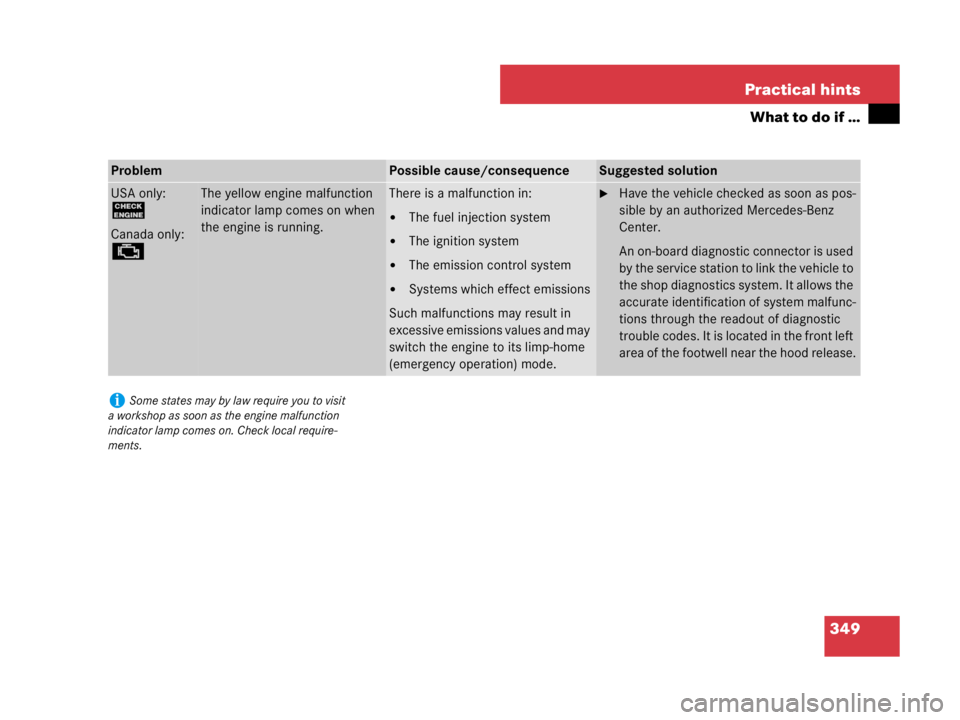
349 Practical hints
What to do if …
ProblemPossible cause/consequenceSuggested solution
USA only:
?
Canada only:
±
The yellow engine malfunction
indicator lamp comes on when
the engine is running.There is a malfunction in:
�The fuel injection system
�The ignition system
�The emission control system
�Systems which effect emissions
Such malfunctions may result in
excessive emissions values and may
switch the engine to its limp-home
(emergency operation) mode.
�Have the vehicle checked as soon as pos-
sible by an authorized Mercedes-Benz
Center.
An on-board diagnostic connector is used
by the service station to link the vehicle to
the shop diagnostics system. It allows the
accurate identification of system malfunc-
tions through the readout of diagnostic
trouble codes. It is located in the front left
area of the footwell near the hood release.
iSome states may by law require you to visit
a workshop as soon as the engine malfunction
indicator lamp comes on. Check local require-
ments.